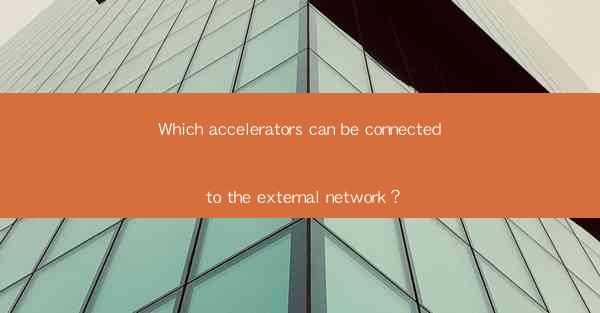-

Introduction to Accelerators and External Networks
Accelerators, in the context of computer networking, are devices that enhance the performance of data transfer by increasing the speed at which data packets are processed. These devices are crucial in high-speed networking environments where large volumes of data need to be processed quickly. External networks, on the other hand, refer to networks that are not part of a local area network (LAN) but are connected to the wider internet. This article explores various types of accelerators that can be connected to external networks to improve performance and efficiency.
Types of Accelerators Suitable for External Networks
1. Network Interface Cards (NICs): NICs are hardware components that enable a computer to connect to a network. High-speed NICs, such as those supporting Gigabit Ethernet or 10 Gigabit Ethernet, can significantly enhance the data transfer rates on external networks.
2. Content Delivery Network (CDN) Accelerators: CDNs are distributed systems of servers that work together to provide fast delivery of content to users. CDN accelerators optimize the delivery of web content by caching it at various strategic locations, reducing latency and bandwidth consumption.
3. Load Balancers: Load balancers distribute network or application traffic across multiple servers to ensure no single server bears too much demand. This helps in maintaining high performance on external networks by preventing any single point of failure.
4. Firewall Accelerators: Firewalls are essential for network security, but they can introduce latency. Firewall accelerators offload the processing of firewall rules from the main CPU, thereby reducing the impact on network performance.
5. SSL Accelerators: Secure Sockets Layer (SSL) encryption and decryption can be computationally intensive. SSL accelerators offload this processing from the CPU, ensuring secure data transfer without compromising on speed.
6. WAN Optimization Appliances: Wide Area Network (WAN) optimization appliances are designed to improve the performance of data transmission over long-distance networks. They use techniques like compression, deduplication, and caching to reduce latency and bandwidth usage.
7. Application Accelerators: These accelerators are designed to enhance the performance of specific applications, such as databases, file servers, or web servers. They optimize the application's data processing and storage, leading to improved performance on external networks.
Considerations for Connecting Accelerators to External Networks
When connecting accelerators to external networks, several factors should be considered:
1. Compatibility: Ensure that the accelerators are compatible with the existing network infrastructure and protocols.
2. Scalability: Choose accelerators that can scale with the growing demands of the network to maintain optimal performance.
3. Management: Consider the management capabilities of the accelerators, such as monitoring, configuration, and reporting tools.
4. Security: Ensure that the accelerators do not introduce security vulnerabilities into the network.
5. Cost: Evaluate the cost-effectiveness of the accelerators in terms of their performance improvement and return on investment.
6. Vendor Support: Select vendors that offer reliable support and maintenance services.
7. Future-Proofing: Choose accelerators that can adapt to future technological advancements and network requirements.
Implementation of Accelerators in External Networks
The implementation of accelerators in external networks involves several steps:
1. Assessment: Evaluate the current network performance and identify areas that require improvement.
2. Selection: Choose the appropriate accelerators based on the network requirements and performance goals.
3. Configuration: Configure the accelerators according to the network's specifications and security policies.
4. Testing: Conduct thorough testing to ensure that the accelerators are functioning as expected and improving network performance.
5. Deployment: Deploy the accelerators in the network infrastructure, ensuring they are connected to the appropriate points.
6. Monitoring: Continuously monitor the network performance to ensure that the accelerators are providing the desired benefits.
7. Maintenance: Regularly maintain and update the accelerators to keep up with evolving network requirements and technologies.
Conclusion
Connecting the right accelerators to external networks can significantly enhance data transfer speeds, reduce latency, and improve overall network performance. By understanding the types of accelerators available and considering the factors mentioned in this article, organizations can make informed decisions to optimize their external network performance. Whether it's through NICs, CDN accelerators, load balancers, or application-specific accelerators, the right combination of devices can ensure that external networks operate efficiently and effectively.
相关阅读:
Quick connect accelerator cracked version download
What is the name of the accelerator connecting foreign count
The accelerator can be connected to the external network
Quick connect npv accelerator cracked version
Mavericks Accelerator official website Genuine Download Port
Cracked version of the game daquan in-house purchase cracked
Computer game free accelerator
版权申明:本文出自纸飞机中文下载网
转载请保留出处和本文地址:https://tgxzw.com/zhifeiji/30883.html
-
Which accelerators can be connected to the external network?
发布时间:2025-03-22 02:04 分类: 纸飞机教程
最新文章
- 2025-05-16 10:44京东小程序的物流怎么查—京东小程序的物流怎么查物流信息
- 2025-05-16 10:40京东下单的电话号码怎么查、京东怎么看订单电话
- 2025-05-16 10:34京东物流怎么查单号,京东物流怎么查单号查询
- 2025-05-16 10:29京东物流手机号查询快递、京东物流手机号查询官网
- 2025-05-16 10:25京东物流快递单号怎么看_京东物流快递单号怎么看物流信息
- 2025-05-16 10:19京东物流快递单号查询入口_京东物流的单号查询
- 2025-05-16 10:15京东物流快递查询电话号码、京东物流查询电话是多少
- 2025-05-16 10:10京东物流电话号码查快递;京东物流电话号码查快递单号
- 2025-05-16 10:04京东物流电话的号码—京东物流电话是什么
- 2025-05-16 09:59京东物流电话查询物流信息_请问京东物流的电话是多少